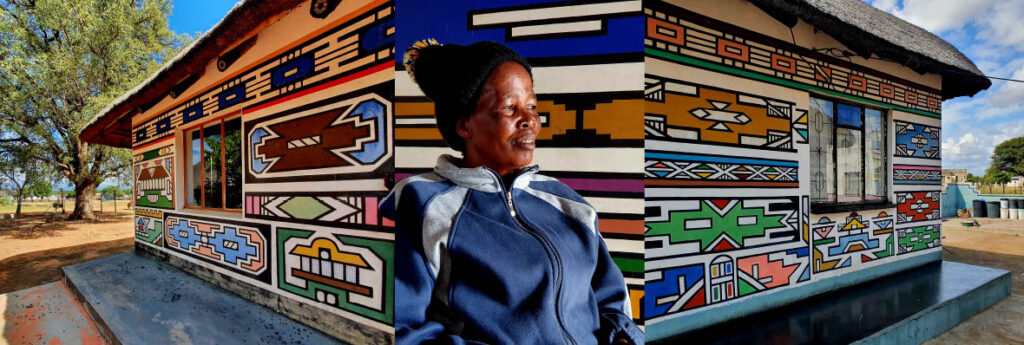Leaving Soweto in rush hour traffic is not for the faint of heart. Motorists overtake on the left and right, stop suddenly for no apparent reason, goats wander across roads, yapping dogs, chickens darting here and there. It became apparent too that being overtaken by another vehicle was considered a personal humiliation and letting one through undoubtedly constitutes a lack of resolve.
Soweto’s motorists are oblivious to the world around them, and no doubt consider their vehicles as their own ‘private’ territory – a kind of mobile plot of land. Some transport farm animals as passengers inside their vehicle, whilst the human passengers are forced to sit astride the open windows, holding onto roof racks.
A cop car pulled me over, blue lights flashing. “You ran a stop sign,” said the burly policeman. “Where? There’s no stop sign,” I exclaim. “Yes, there is. There,” he pointed in a northerly direction. I get out the car and ask him to show me. We walk a few hundred metres to a metal pole. “There is the stop sign,” he was agitated at this point. “But that’s not a stop sign, that’s a pole,” I squeaked. “The sign was stolen,” said the cop. “But everyone knows this is where they must stop. And you did not stop.” I looked for road markings indicating a stop street and saw none. “So, I will gift you this fine for not stopping at the pole where it once said you must stop!” It was a futile argument, so I receive his gift with thanks and proceeded.
Then my SatNav decided to take a nap, and my mobile phone stopped working. Mild panic began to set in. I could envision the headlines now – ‘acclaimed world traveller disappears in Soweto’.
Then I saw a couple of gun wielding cops’ jet-washing their police vehicles. In near tears of anguish, I asked for help.
Constable Marubini Raphebele of the Soweto K9 Unit took over. He poked at the SatNav screen then called Land Rover, explaining the problem. The Land Rover’s tech guy said I should meet him at Centurion Park, which my new policeman friend said he’d escort me to.
After hanging up the phone, he poked at the screen some more, disconnected my Android, which apparently was the cause of it all, and voila, the SatNav is working.
My somewhat delayed journey now continues to Mpumalanga – 4 hours drive east. Here I met Helen Ndimande who lives in a brightly painted house in the village of Mabhoko. Helen is of the Ndebele tribe whose women sustain their cultural identity through the powerful visual language of their beaded body adornments and distinctive homestead murals.
The women of the Ndebele tribe are the carriers of tradition and are the main developers of the wall art on their home’s external walls. This style of house painting is passed down through the generations. A well-painted home is considered to demonstrate the female of the household to be a good wife and mother. It’s an architectural style that makes their square family homes a ‘village’ of geometric design murals. Initially only earthy pigments were used, then they added a colour to their palette (from Reckitt’s Blue laundry detergent), which gave splashes of glorious ultramarine to the walls. Later, when oxides became readily available, vivid reds, greens, and yellows where added. Traditionally, murals were redone every year as the summer rains washed away the pigments, but the arrival of latex paints meant colours remained vivid for much longer.
“When I was a young child,” says Helen. “I would add paint powder to mud and paint Ndebele geometric patterns onto the chicken coops. Then, when I got a little older my mother taught me the intricate art of my heritage. In turn I have taught my daughter and have 35 art students at the school.”
We take a walk across the dusty road to the traditional school she referred to. She teaches kids the art on paper first then, when they get the hang of it, they’re given a small piece of wall.
In the office is an image of supermodel Iman when she visited the school a few years ago.
Sleep: Loskop Valley Lodge, the largest Lodge of its kind in the immediate vicinity is calm, peaceful, and incredibly busy with birdlife. Willem and Joey Janse van Rensburg have created a piece of paradise here, with a tropical garden, basic lodge-style rooms, and really good food. At breakfast, two rotund and amiable businessmen joined me – uninvited. “We see you are alone. This is not good. So, we sit here.” And they did.
With several packs of biltong, crisps, slabs of chocolate (food for the road), soft drinks, and a toilet roll (here you travel with your own toilet roll), I’m back on the road heading further east, nearing the Kruger National Park/Mozambique border, pointing towards Hazyview.
This is huge farming country. Emerald green expanses of citrus trees stretching over the horizon, banana plantations, cane, wheat. Then it’s miles and miles of dark woods, followed by bushveld, mountain passes, dams, and rivers.
Self-drive: Driving a Land Rover Defender 90 D300 through this kind of terrain is essential and makes for an effortless ride. From my ‘umpire seat’ vantage point I can see far and wide. With all its on-board tech even a complete novice 4×4 driver feels like a pro. The Defender 90 has a tough and massive off-road presence and looks the business, attracting many admiring glances. It’s smooth and comfortable and glides over road surfaces like a hovercraft. Following many hours at the wheel I disembark with no aches and pains. It purrs along productively, and for a sizable 3-litre, dare I say this diesel is economical.
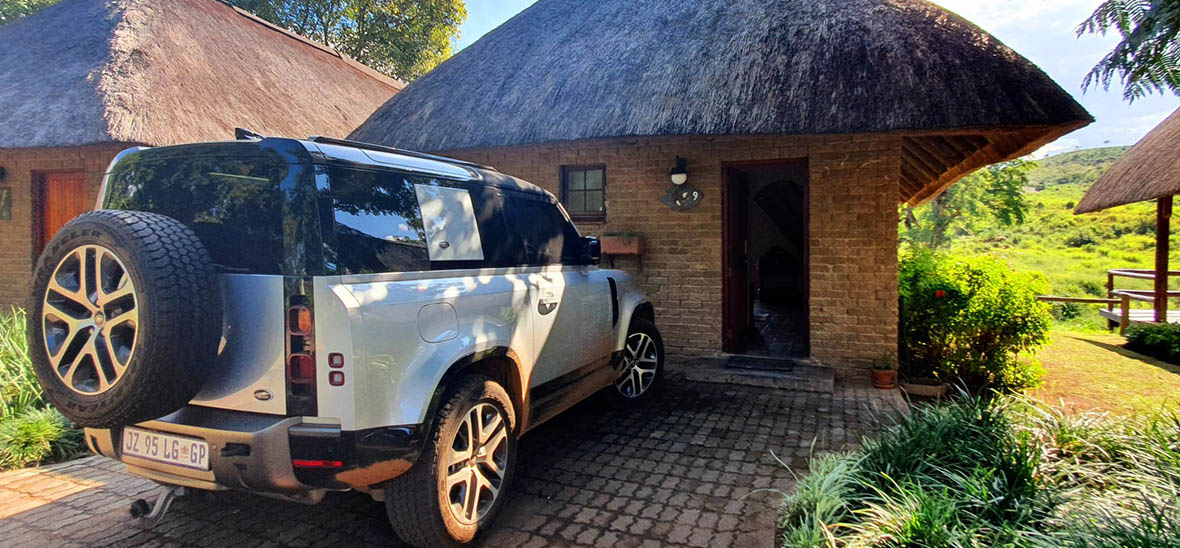
Sleep: Eventually Hippo Hollow Country Estate comes into view. It’s a comfortable hotel on the banks of the Sabie River, with sprawling indigenous gardens. I’m here for a couple of nights and opt for a river-side chalet which is perfect for small families (as opposed to a room in the hotel) and comes with a kitchenette and deck overlooking the Sabie River.
I’m sitting outside, listening to the continuous cascade of water over a nearby weir. The air is filled with incessant night-time insect sounds of crickets, frogs, and cicadas, which is further punctuated with the distinctive loud hiss, grunts, and tuba-like snorts from the hippos. These are the African sounds that’ll set me off to sleep in my chair.
Mpumalanga’s Panorama Route is about 160km in length and runs between Lydenburg, the borders of Mpumalanga, Limpopo, and near the Echo Caves. It includes the Long Tom Pass – one of South Africa’s most scenic mountain passes, and the 26km long Blyde River Canyon, the third largest canyon in the world. But unlike others, this is a ‘green canyon’ dominated by subtropical vegetation.
God’s Window in the southern extremity of the Blyde River Canyon Nature Reserve is one of the most famous natural features along the Panorama Route. On the edge of a cliff face that drops a dizzying 700m, God’s Window is what it says. The views are spectacular – from the edge of the Drakensberg mountains across the Kruger National Park to the distant Lebombo Mountains on the border with Mozambique. This sheer cliff edge stretches relatively unbroken for approximately 250km. And on a clear day you can see the curvature of the earth.
Then there’s Lone Creek Falls – one of the well-known landmarks which plummets 70m into the creek. The waterfall will take your breath away with its natural beauty. It’s something truly exceptional to behold.
Three Rondavels are three round mountains with slightly pointed tops, very similar to the traditional round African homesteads made with local materials and are called rondavels. The view makes my heart ache, a sight that’ll stay with me forever.
Bourke’s Luck Potholes are the result of decades of swirling eddies of water where the Treur River meets the Blyde River, the tumult of which has caused extensive water erosion over time. The result is a series of cylindrical rock sculptures that look as though they would be more comfortable on the moon.
At 92m, the Lisbon Falls are the highest in Mpumalanga. The river separates into three streams as it plunges into the pool below. Much like the Berlin and Mac Mac Falls, the Lisbon Falls are named for the foreign miners that settled in the region during the gold rush – in this case, a handful of Portuguese pioneers.
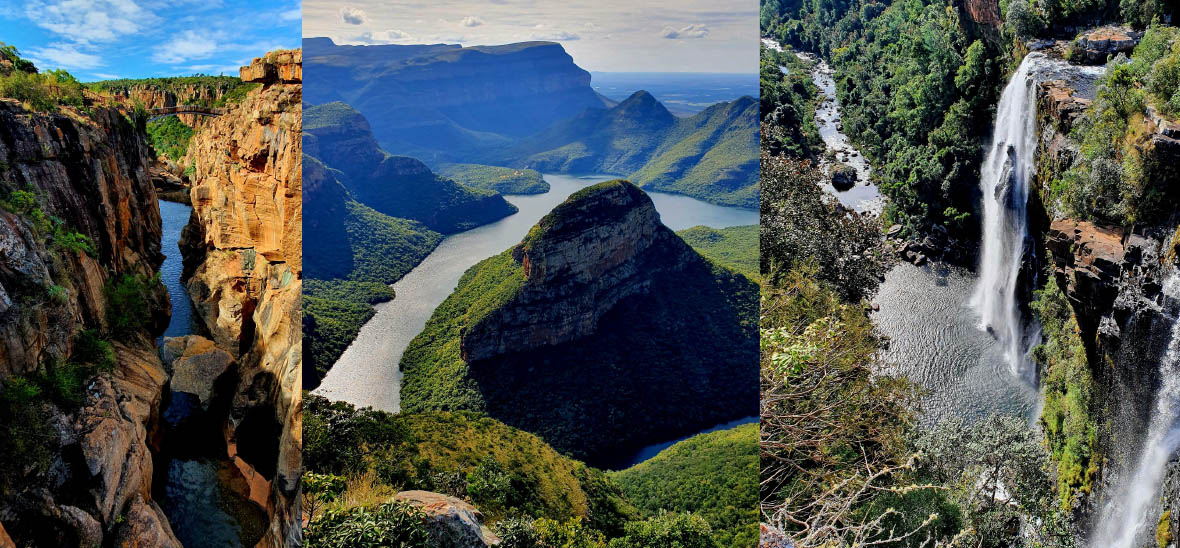
How the name Blyde River Canyon came to be is an interesting one: in 1844 a group of Voortrekkers under the leadership of Hendrik Potgieter tried to find a trade route to Mozambique and decided to leave their wagons and families a few kilometres upstream, while continuing on horseback. When the explorers didn’t return on the agreed date, the remaining Voortrekker families named the river where they’d been camping as the Treur River (river of sorrow). They decamped and turned to go back West. But they hadn’t gone too far when Potgieter and his men caught up with them. They had found a route to Delgoa Bay in Mozambique and had also signed a trade agreement with the Portuguese colonialists. The Voortrekkers named the river where the group caught up with them the Blyde River (river of joy). They settled in the area soon after.
But it’s not all sweet-smelling roses. SAFCOL, South Africa’s forestry department, have decimated the natural flora and fauna, and eradicated indigenous trees, replacing them with thousands of pine tree plantations. And the roads, traversed by the logging trucks are ruined with crater sized potholes. Although some road works are underway, it’s not nearly enough.
Heading out of Mpumalanga I take a 4-hour journey North, travelling through the lush, green vegetation of the Limpopo Province; my ultimate destination, the Nahakwe Lodge.
Winding roads hugging the mountains, gave way to bush, then plantations of banana trees and maize, then more bush – the electric fences along the road verges hinting at what lay within. I passed several ‘Route Maintenance’ vehicles, who’d stop to pick up road debris and wondered why this model was not implemented throughout the country.
The rain turned into a dramatic thunderstorm which briefly refreshed the green landscape, turning the deep terracotta soil Paprika red. This of course offered a driving opportunity I could not resist. Along several miles of dirt road detours, I stretched the Defender’s legs, pushed a few buttons, and set off down a wet track, broadsiding around bends. It literally did ‘hovercraft’ moves over potholes and speedbumps, like they weren’t even there! And I could feel the Defender was loving it. Massive respect for this 4×4.
Sleep: Nahakwe Lodge is of 4-star standard, comprising 10 air-conditioned free-standing chalets, a restaurant serving traditional food, and a sparkling swimming pool. These accommodations are best suited to the adventure travellers who seek to explore the Limpopo Province.
Owned by the local community, the Lodge was opened in 2015 as a showcase of a modern community-owned tourism enterprise. The hotel’s biggest draw is its direct links with communities on the Ribola Art Route.
Whilst my camera batteries are recharging, Hotel Manager, Betty Hlungwami, props me up the deck with a stiff G&T and discusses the itinerary for the next three day. I found it hard to focus as my attention kept being drawn to the massive view of the surrounding bushveld.
With a cooler brimming with soft drinks and treats for the road (and the prerequisite toilet roll in the glove box), Betty and I piled into the Defender, and set off in the direction of the mist covered Ribola mountains, and the Ribola Art Route it houses.
Creating designs on plain white cloth is what the women at Twananani Textiles do. Since 1983 Florence Ngobeni (head seamstress), Evelyn Makhubele, and Yimisa Ngobeni, who are part of a small women’s cooperative, create batik fabrics.
How it works sounds simple – drawing out or trace a pattern onto the linen fabric, brush melted wax onto the pencilled lines, then paint bright colours (powdered paint, water, salt) over the design, wash in hot, salted water, then leave to dry flat.
I put it to the test and can safely say it’s not as easy as it looks. It’s massively time consuming, the wax brush strokes need to be delicate, with heavy application so that the wax seeps through to the back of the fabric. The paint application is intricate and requires a steady hand. Under stern guidance, my amateur attempt resulted in a rhino, crocodile, and guinea fowl combo that looks fantastic.
Pilato Bulala is a young sculptor, who uses scrap metal to create alternative art. When he was a boy there wasn’t money for toys, so he improvised, and made his own, using scrap metal. Winning a design competition at school set him on the art track.
Each of his metal sculptures tell a story – Russia vs Ukraine, depicting an armoured tank with bodies lying in front of it; then there’s the Soweto uprising; Archbishop Desmond Tutu; boxer Nelson Mandela; and many focused on Covid and the vaccine.
Seeking sustenance, we stopped at Ceasar’s Chicken shack for lunch. Sara Hlungwani preps the pap (maizemeal), spinach, cabbage, and chakalaka; whilst Oscar Mbedzi barbecues the chicken, lathering it with hot Nando’s-type sauce. Dining like a local, I dig into the delicious offering with my fingers.
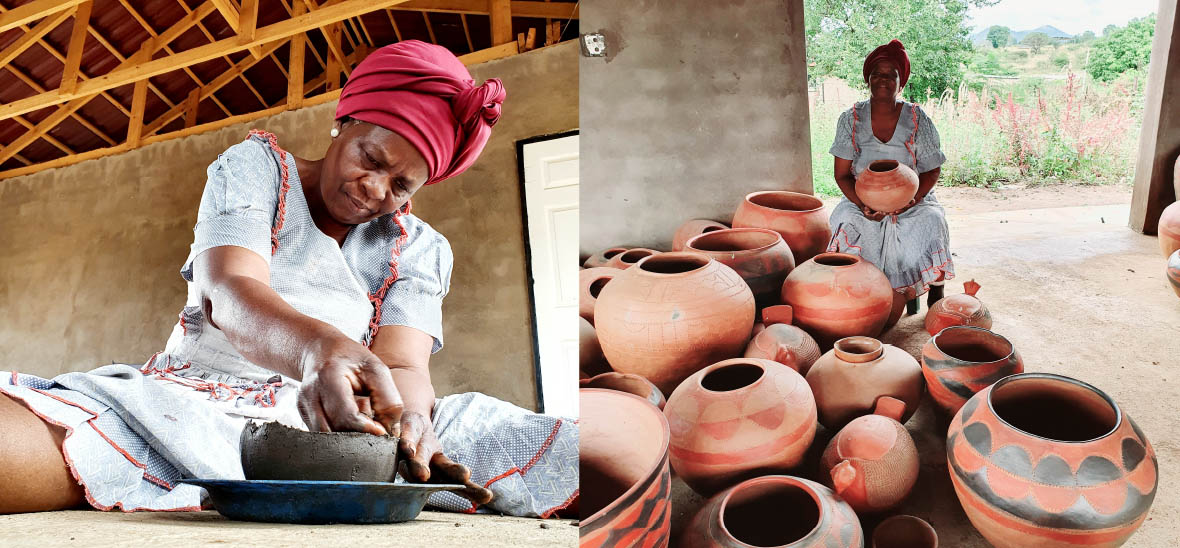
Mukondeni Village Potters is composed of twelve lady potters – Flora Randela is their champion, and her mother-in-law, Angelina Selapyane, her guide. They unearth the black clay from a nearby gorge then mould it into bowls or vases. This left to dry indoors, covered with blankets. Soon thereafter it’s time to fire up the kiln and smoulder the pottery under firewood, grass reeds, zinc, then topped off with more firewood. It’s left to slow bake for 24 hours. It’s at this point the black clay turns brown, and often includes shapes and swirls of ground black graphite.
Through her art, Flora has seen her children through university. In thanks, they built her the new, modern home we stood in.
Traditional musician, Thomas Kubayi, from Vhutsila Arts & Crafts Centre, has been teaching the local youth the art of indigenous drumming since 2006 – as well as the intricacies of producing wood sculptures.
I step into his studio and am astounded at the detail and finesse of his work. Four of his music students stride in, carrying as assortment of animal-hide drums that had been warming by the fireside. Within moments infectious African drum rhythms fill the room. It’s impossible to keep still.
Kenneth Nonyana is a former student of Thomas Kubayi. His genre is redwood and ironwood sculptures. The common thread running through all his creations is one of nurture. An elderly African fisher woman, adorned with an abundant necklace, another of a husband caressing his wife, a man whistling, a woman singing, others embracing, more still unified. There’s so much to read in their postures, and facial expressions, even the eyes – the detail is infinitely intricate.
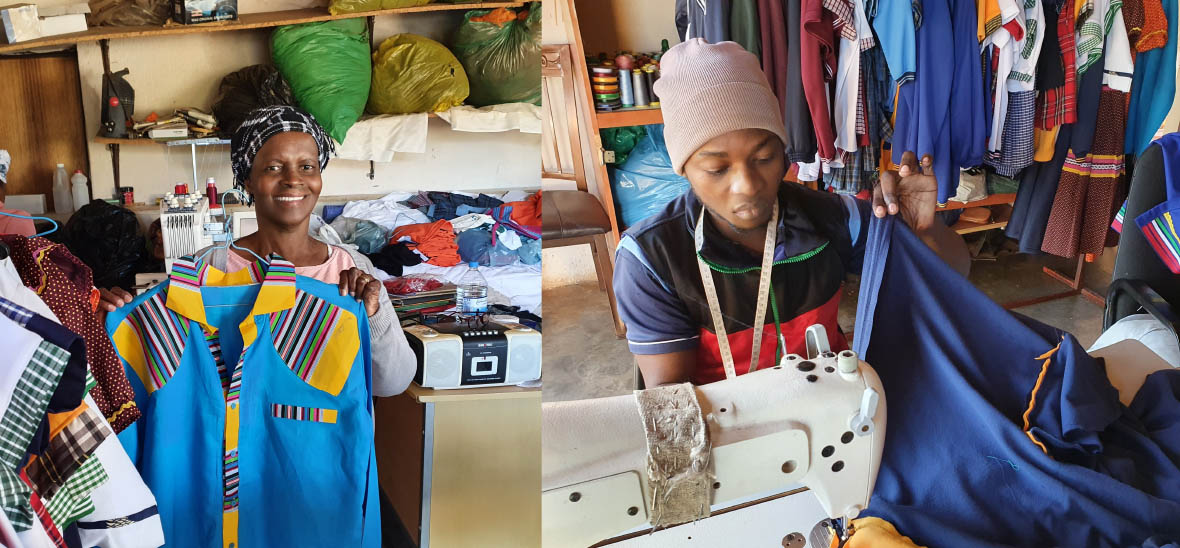 Housed in a double garage attached to her modest home is Louise Maepa business – Mocheudi Dressmaking. She’s been at her sewing machine since 1983 making school uniforms for several local schools and outfits for special occasions (which she often caters for too).
Housed in a double garage attached to her modest home is Louise Maepa business – Mocheudi Dressmaking. She’s been at her sewing machine since 1983 making school uniforms for several local schools and outfits for special occasions (which she often caters for too).
“We are 5km from your lodge, in Mamaila Kolobetona Village, which is far from the city with its shops, so it’s easier to come to me. Here nothing is cut with the machines. It is all done by hand.”
She shows me a shirt that would’ve made Nelson Mandela proud to wear. Her nephew, Imani Maepa, is busy sewing a zipper into a school tracksuit. Louise has trained ten others who have gone to opening their own businesses.
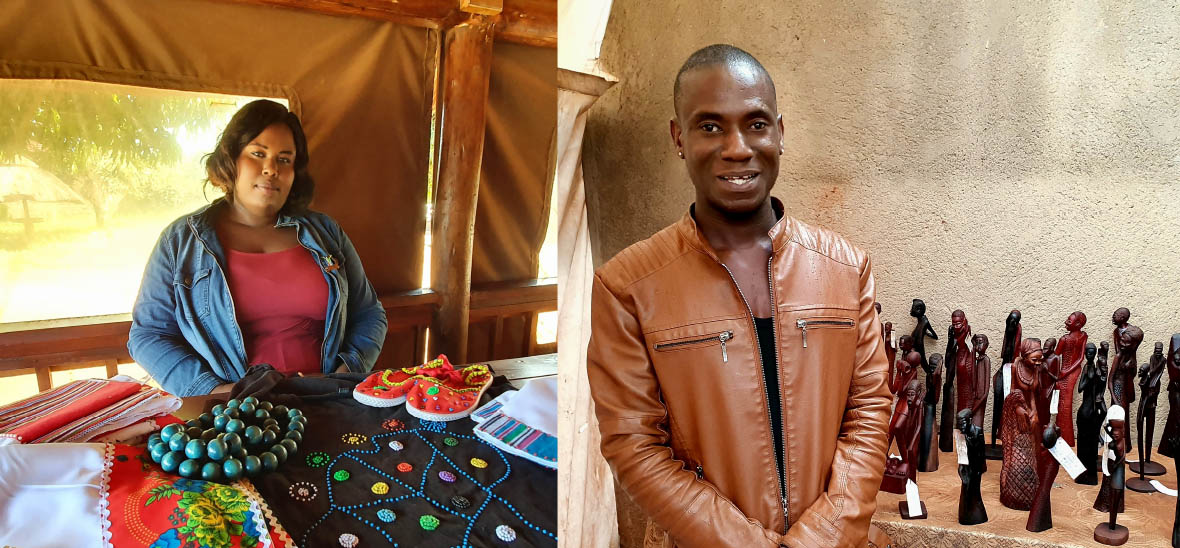
At Johanna Lerisa Mabunda’s home, a spread of brightly coloured beaded accessories are displayed on a reed mat – headbands, necklaces, belts, bracelets, bangles. Each individually crafted by her small hands.
As a girl she worked on a tea farm and began making her own accessories with beads bought from Khoja’s Modern Store, a general dealer, still owned and run by the same Indian family. Her work colleagues loved her traditional bead creations and orders started flooding in.
Years later after she’d married and had children, her business is still going strong. Her children found it hard to believe that she ran the house and put them through school with money earned from what they thought was a hobby.
“My children helped me extend my house by adding two extra bedrooms, and this double garage. We would go down to the river, fill the bakkie (pickup truck) with sand then mix it with cement. From this we make bricks for building the walls.” She looks around proudly.
Amukelani Maluleke and I met at Ceasar’s Chicken shack (now my regular lunch joint) where she packs out her beaded t-shirts, beaded shirts, and a beaded Nceka (sarong). She’s been redesigning clothes since 2012 and learned her art at her mother knee, Evelyn Makhubele, whom I’d previously met at Twanana Textiles.
She shows me what was once a pair of closed canvas tennis shoes. She redesigned them, turning them glamorous sandals by cutting away some of the fabric, adding laces to be tied around ankles, then sewing on an assortment of colourful beads.
When I met Gift Rhulani, I knew at once that Betty, my guide and hotel manager, had been holding out on me. Of all the talented artists I’d met over the past three weeks, Gift is something else.
His uncle was a hip-hop musician and, as a child, Gift was inspired when witnessing the creation of music.
In 2011 he started his home recording studio and, together with Isaac Chuma, and now Vakosi Chuma, the Afro Pop band MBK Boyz was born.
On his deck he played me a song he wrote ‘Ntombhi yale joni’ (a girl from the city). It’s a love story of a girl he met in Johannesburg, then learned she was originally from his own village.
Whether you can understand the lingo or not is irrelevant. Music is an international language, spoken by everyone.
It starts with a slow rhythmic hop-hop beat, with a few twangs of an Indian sitar thrown into the mix. Very soon my head nodding in agreement with every beat. Then came the voices of haunting harmony. This is a new, smooth genre of hip-hop and the kind of music I could never tire of.
This is where the real South Africa is – the rural heartland, undiscovered and unexplored by most.
Driving to Johannesburg’s Oliver Tambo international airport, I’m bopping along to Gift’s music, and realise the only man I envy is the one who has not yet been to South Africa, for he has so much to look forward to.
Halfway home, arriving at my connecting airport, I lurched around with one small suitcase and a heavy camera bag, I got lost, went up and down in an elevator a few times, took an unnecessary train to a random terminal, and had an argument with a passport machine – which turned out to be an ATM. Eventually I found my departure lounge, propped myself up in a corner (with a G&T) and penned these closing paragraph, summarising my thoughts and experiences.
I arrived in South Africa a vegetarian and am leaving a carnivore (having consumed my own bodyweight in biltong). I’ve slept in 5-star hotels and backpacker inns. I’ve squatted down next to a fire in the veld, remembering this easy chairperson way of sitting, and I’ve sat on designer sofas in the country’s best hotel. I’ve wallowed in a bath sprinkled with rose petals and performed my ablutions in washbasin. I’ve dined haute cuisine and eaten pap (maizemeal) using my fingers as forks. The luxurious constant throughout has been the people I’ve met along the way, the artistic talent, the unspeakable beauty of the country, and of course, the car’s that effortlessly delivered me to all of this.
What South Africa has is passionate kindness, genuine hospitality, and unreserved humour. If you’re sitting alone at a dinner table, others join you as “… in Africa you are not alone.” Ask for help, and the whole village lends a hand. And everyone is keen to tell you why their part of the country is best. What I’ve experienced here has reaffirmed my belief in the fundamental goodness in mankind. And this, in a time of global insecurity, gladdens my heart.
For more information: https://www.mpumalanga.com/

